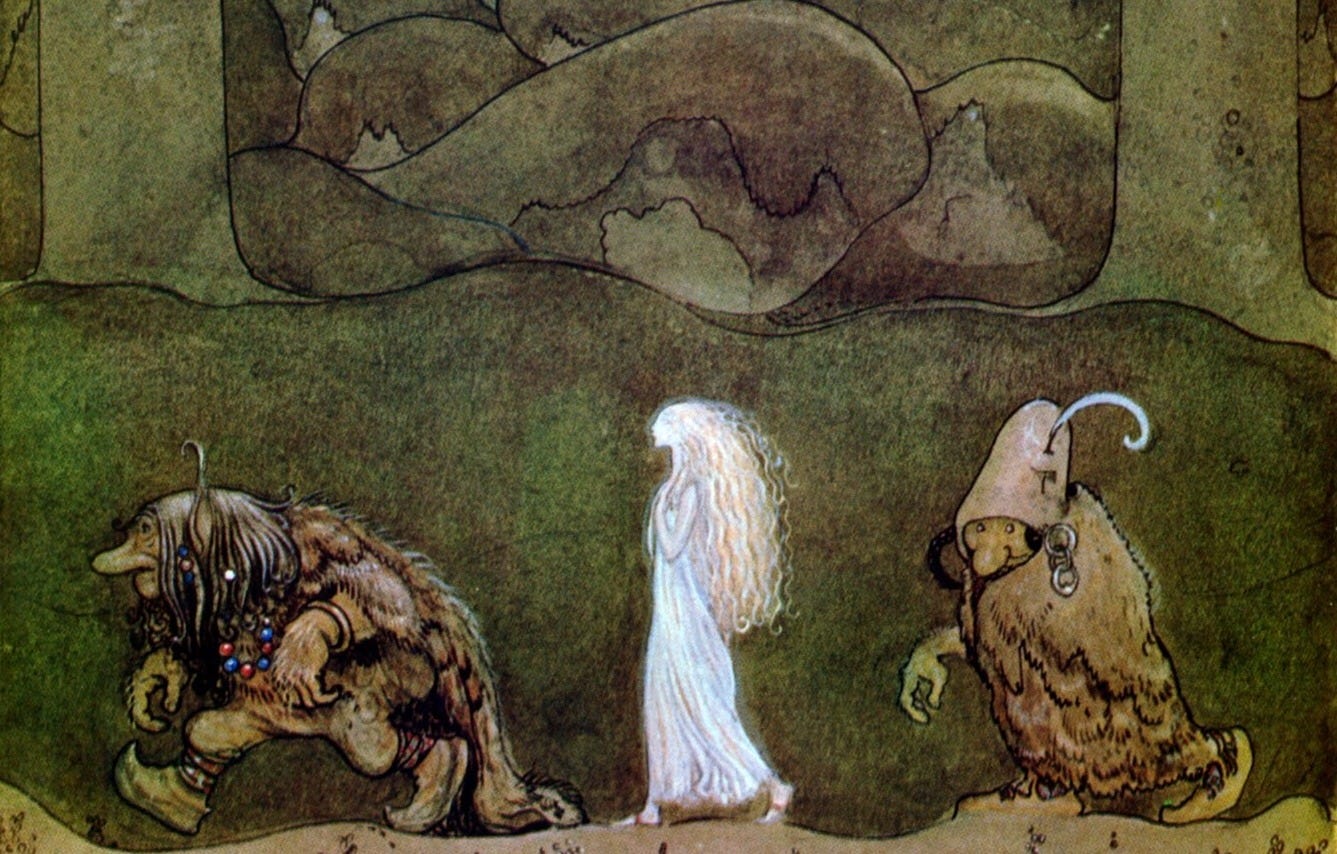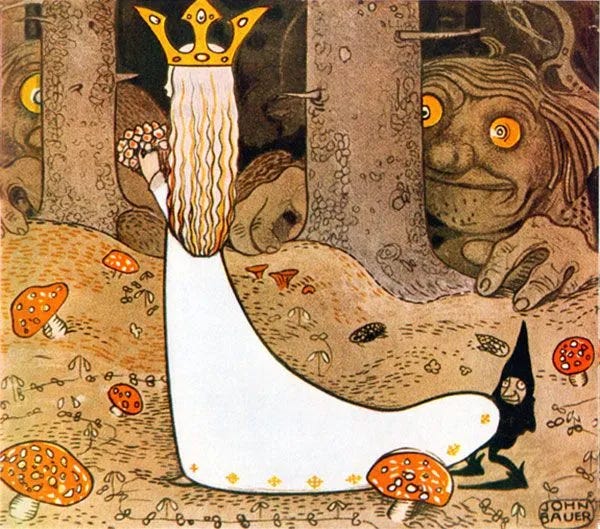What every psychedelic guide should know about fairies
Elf-lore 101
The Global Psychedelic Survey launches today, in what will hopefully be the biggest ever survey. You can complete it in a range of languages at this link. Thanks!
I often mention the psychedelic industry’s entity dilemma - people regularly encounter entities on psychedelics, how should they relate to them? What should guides be taught about them? What should the industry say about them to patients and regulators? So far, the psychedelic pharma industry has maintained an uneasy silence. But others have filled this silence, especially the Christian Right, with figures such as Tucker Carlson, Alex Jones, Rod Dreher and Ross Douthat warning that psychedelics can lead to demonic encounters.
The field sometimes looks to Amazon shamans and what they teach about helpful or harmful nature-spirits. But the problem is, Amazon tribal cultures are largely oral, little is written down, and there are high geographical, cultural and linguistic barriers to learning what they know, not to mention the risk of cultural extraction. But there’s one source of wisdom that so far is almost entirely untapped by psychedelic studies - 2500 years of western folklore and theology about elves, fairies and other daemonic entities. So far, there is hardly any contact between the world of folklore studies and psychedelic studies on this topic - with one or two noble exceptions. We should talk more.
What follows is a fairy primer for psychedelic guides. It’s a fun topic, potentially useful, and important - because the future attitude of Christian churches to psychedelics might come down to the attitude of Christian churches to fairies. There’s very little contemporary Christian theology on psychedelics, but a surprising amount on fairies and some good precedents from the likes of CS Lewis, JRR Tolkien, and other favourites of the Christian Right.
There are (at least) four ways to think about fairies.
Socio-historical - the history of fairies
Experiential - case reports of encounters with fairies
Psychiatric - medical reports of seeing little people either through drugs or illnesses
Theological / theurgic - how we should relate to fairies
A brief history of fairies
This is the easiest way to study fairies - ignoring the question of their possible reality and instead focusing on the social construction of fairy belief in different times and places. There is a rich body of literature on the history of fairy belief, by folklorists such as Ronald Hutton, Francis Young, Simon Young, Katharine Briggs and others (I’m not an expert so forgive me if I left out important names).
The history of fairies can be put into five phases. The first phase is classical. The origin of fairies is generally considered to be the nature-spirits of ancient Greece and Rome - satyrs, nereids, elementals, fauns, genii loci, guardian spirits and so on. Such beings were called daimones by Plato and ‘godlings’ by Francis Young - they’re supernatural, but not as powerful as gods nor as distant, but rather half-way daemons between gods and humans. They still exerted a powerful influence on human affairs, indeed the word ‘fairies’ comes from the Latin fata meaning ‘fates’. Because they were closer to humans than the Olympian gods, you could interact with them for sex, luck, healing, creativity, or to enhance the fertility of your marriage or your fields.
The second phase is the Christian re-interpretation of fairies. The church fathers seem to have been divided on how to view these pagan nature-spirits, in the first centuries of Christianity. Augustine declared there is no such thing as a good or helpful daemon or nature spirit, they’re all evil and misleading. Origen, by contrast, writes: ‘We indeed also maintain with regard not only to the fruits of the earth, but to every flowing stream and every breath of air…that the air is kept pure, and supports the life of those who breathe it, only in consequence of the agency and control of certain beings whom we may call invisible husbandmen and guardians; but we deny that those invisible agents are demons.’
The third phase is during the Dark Ages and early Middle Ages, when people still had encounters with strange, small, supernatural beings, but they had no stable belief system to put them into. They were just weird anomalous encounters, like the ‘green children of Woolpit’ - two green children who appeared in Sussex one day, claiming to have come from a twilight land.
The fourth phase, during the Middle Ages, is the high-point of belief in fairies, when they become part of a relatively settled body of folklore, and were classified into different types of being. There are fairies, elves, pixies, gnomes, house-spirits, the sidhe of Ireland, the Seelie and Unseelie Court of Scotland, the duendes of Spain, the pouques of Guernsey, the trows of Orkney, the trolls of Scandinavia, and so on. And there could be subdivisions and many types within one fairy ecosystem. Just in Scotland there were, according to Ceri Houlbrook,
the malevolent bogles; the mischievous bauchan; the kindly doonie who guide those in difficulty; the evil redcaps who inhabit the Borders between England and Scotland; the domestic urisk, eager to help with household chores; and the bean-nighe, the Scottish equivalent of the banshee who shrieks and wails in prophecy of death; the taunting Hobyahs from Perth — and this is to name only a few. There were also animal species of fairies: the each uisge (water-horse), the crodhamara (water-cattle), the roane (seals), and the fairy dog of the Highlands known as the cu sith.
Here in Costa Rica, many still believe in duendes, small playful forest folk. My mother-in-law saw one when she was a child, so did my wife’s best friends, and most of her rural family believe in them. ‘They just want to play’, my wife explains to me, ‘and they don’t care if you die’. So basically like psychedelic culture! Kidding!
Another classification used by modern folklorists is between the ‘solitary and social supernatural’. You have solitary supernatural beings, lone fairies, which are considered more moody and dangerous to humans, and then you have fairy societies, which reflected medieval courts, had fairy kings and queens, and devoted themselves to the traditional courtly pursuits of dancing, feasting and hunting. It was believed that the two societies - fairies and humans - need each other. Why do fairies need us? In many ways they are more powerful than we are, but they lack certain capacities or skills - such as midwifery apparently. Sometimes they take humans as lovers, and sometimes they take our children, leaving changelings or ‘oafs’ in their place.
Why do humans need fairies? They can grant boons, particularly fertility to marriages or crops or livestock, they can ensure the orderliness of your house, or grant gifts of healing, prophecy or music. They can also lead you to treasure, like leprechauns. In some belief systems, fairies can also grant political power, so human society is deeply dependent on its favour. King Arthur was believed to be half-elvish, while the entire Gaelic people are, according to one myth, descended from interbreeding with the elvish Tuatha De Danaan (folk of the goddess Danu).
So those are the good things that fairies can bring to humans. But the list of bad things is a lot longer. They often cause harm, bad luck, illness or death to adults, children, crops or livestock. They can harm you by firing ‘elf-shot’ arrows at you, much as Amazon shamans fire magic darts at their enemies. They may decide to abduct you for a while to one of their balls, which like a psychedelic experience stretch time:
Two young men once called in at a fairy house where there was a party going on. One danced away and took a drink, while the other tired of waiting for him and left. When the second man visited the house exactly one year later, his friend was still dancing away and on leaving did not realize that a year had passed.
Any encroachment into Fairyland, intentional or accidental, was highly perilous:
Once there, it was very difficult to leave. Even if the hapless wanderer followed the well-known rules for surviving Fairyland — don’t eat or drink; don’t speak; and don’t accept gifts — and was able, or allowed, to escape, they might find themselves the victim of time distortion: one night in Fairyland could amount to years in the mortal realm.
Above all, fairy morality is unpredictable. Francis Young says this is why fairies were so feared:
The recurring and terrifying theme within fairy narratives is the fact that they have these rules, but we don't fully understand what those rules are, and therefore you can very easily offend them, cross that line without realizing it, and end up very bad place.
Fairy morality is markedly lacking in Christian forgiveness and mercy or liberal fairness and justice. Francis Young again:
To give you a classic example, there’s an Irish story about a hunchback who goes to sleep in a fairy fort, which you really shouldn’t do. He is woken by the fairies, and because he says kind words to them, they decide ‘we’re going to take the hump off your back and send you home’. Another hunch-back hears this, goes to the same fairy fort and goes to sleep. But the fairies know he’s only there to try and get the same cure, so they decide to give him a double hump. Fairies have this strong sense of morality, but they are capable of a level of brutality which is beyond our comprehension, in that there are absolutely no-holds-barred punishment for any kind of infraction. There's no sense of proportionality.
Fairy doctors
Some rural societies had figures to do business with the fairy world – in some ways a comparable figure to the shamans of Siberia or the Americas. They were called ‘fairy doctors’, ‘fairy gossipers’ or ‘cunning men’.





